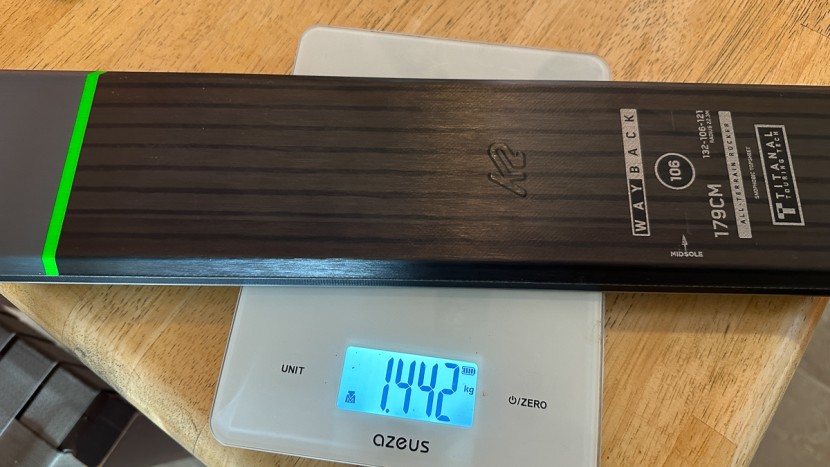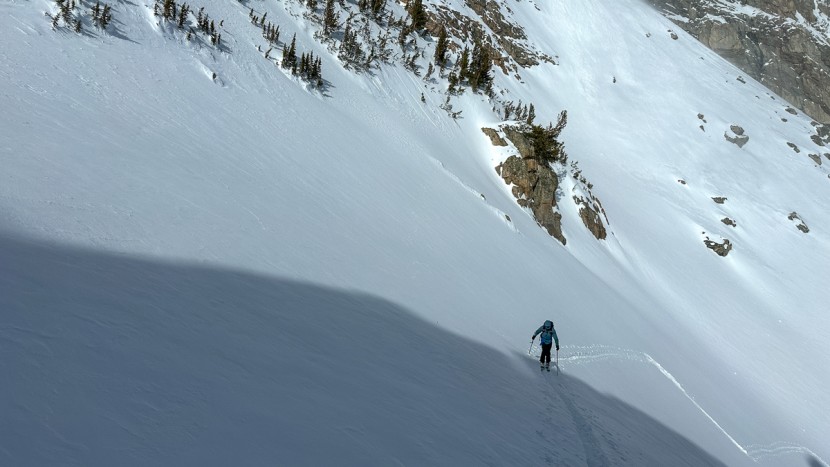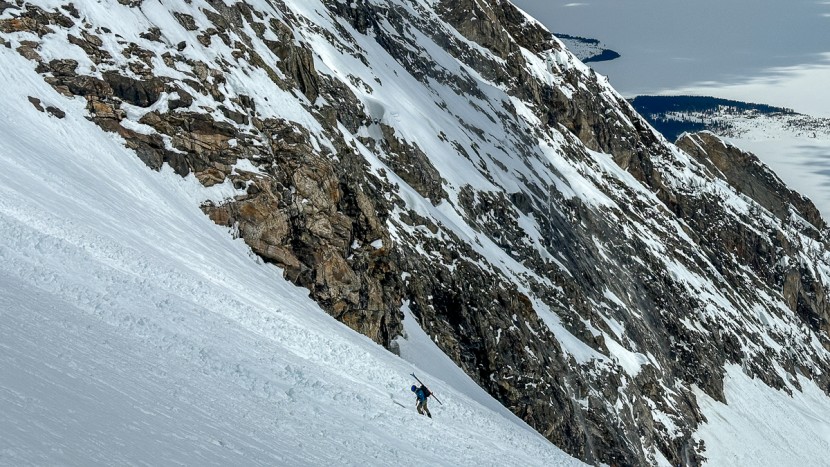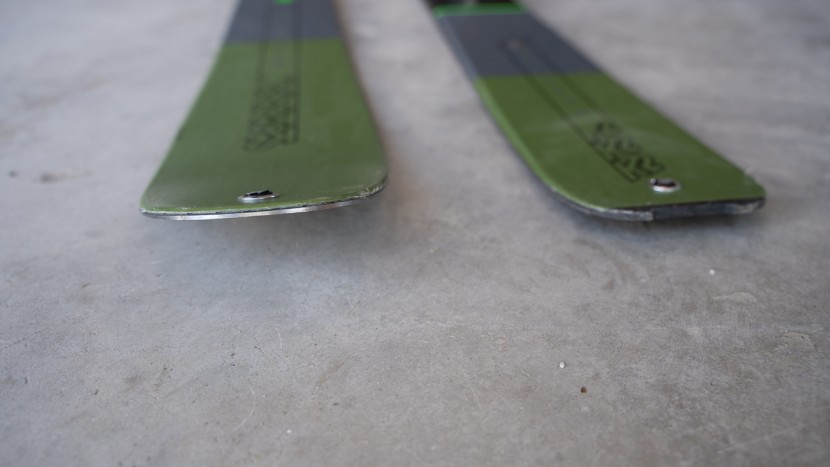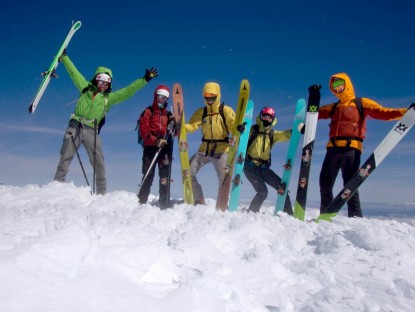
Our Verdict
Our Analysis and Test Results
K2's damp, predictable, centered performance near a “sweet spot” size and weight – 106 mm underfoot and 1436 grams per ski – should appeal to a wide variety of backcountry skiers. The findings from our latest round of testing were very consistent with what we have known and loved for years. We recommend these skis to so many people, and the relatively low price point means that many are more than happy to take us up on our recommendation. K2 distributes the popular Wayback collection through a broad, well-established dealer network, which makes it easy to find a pair of these skis (and often easily, on sale).
Weight
The newest Wayback 106 sports the same dimensions, yet it weighs 100 grams less than the previous versions we tested. We weighted them on a calibrated digital scale, acknowledging that all skis vary in weight from one to the other (which may be surprising to some of our readers). Convention has settled on communicating about ski weight in terms of one ski, weighed in grams. We'll follow this convention.
Our test pair of 179 cm skis weighed 1430 and 1442 grams, respectively – that's an average of 1436 g per ski or 2872 g for the pair. For those of you who prefer imperial units, that converts to 6.3 pounds for the pair. In context that's remarkably lightweight for a ski that's 106 mm underfoot. There are other huge, ultralight skis and plenty of skinnier, stiffer chargers on the market. But skis like the Wayback 106, weighing somewhere in the range of 1400-1600 grams, offer the greatest versatility.
The Wayback 106 is a well-tuned, all-around backcountry ski. Go lighter, and you compromise versatility or fun on the downhill in the interest of uphill efficiency. Go heavier, and you work more on the uphill for marginal (and, in our opinion, debatable) downhill performance gains. In short, the Wayback 106 is right at the sweet spot for the weight of a touring ski – we certainly have no complaints.
Firm Snow
On icy snow, the Wayback 106 is more than “good enough”. Due to their size underfoot and flex pattern, you wouldn't want to pick these as dedicated groomers or spring ski mountaineering skis. However, if your travels or season demands that you take on some ice (as most backcountry skiing does), your all-around well-performing Wayback 106s won't let you down.
Something stiffer and narrower will definitely grab more, but its edge hold is acceptable. After putting in the time to adjust your stance to the flex pattern of the Wayback 106, they'll easily adapt to skiing firm snow during mid-season drought periods. But if you jump on these for an early-season “white ribbon of death” ski resort trial lap, you will quickly find their limits of skiing firm snow, and likely be underwhelmed. They're not hard snow specialists, but they can keep up.
Powder
This is what you train for. This is what you get up early for. This is what the Wayback 106 is tuned towards when it comes to skiing the goods. You could get dedicated powder touring skis – of course, they exist, and it is nice to have a specialist pair for particularly deep days. But practice shows that our best backcountry powder days are usually on our all-around touring skis.
If you think about your powder skiing experience holistically, you'll find that a ski like the otherwise unassuming Wayback 106 is just the ticket. All else equal, bigger, fatter skis might be marginally better. But they are heavier – don't forget that you have to skin through all that fresh snow before you get to ski it. A well-rounded option, like the Wayback 106, strikes a fantastic balance of weight and comfort on the downhill. If our studies prove anything, it's that you're more likely to reach for a familiar ski like this when the flakes fly.
Crud and Poor Snow
Generally, you aren't seeking out bad snow, and neither are we. (Well, we do seek it out for testing). In that testing, we were very pleased with the poor snow performance of the Wayback 106. On one horrendous pitch of breakable crust, we found that we could maintain parallel, energetic turns into the pitch without flaming out our legs or risking an ugly face plant.
Most people just want to survive the sections of tough snow conditions, which you inevitably hit somewhere and at some point in your season. When the going gets tough, the edges of the Wayback 106 don't tend to grab, the lightweight tips generally don't dive, and the trajectory stays consistent. Other skis performed better in this metric, but they are also much heavier. For the weight and size, no other ski we tested is appreciably better than the Wayback 106 in bad snow conditions.
Stability at Speed
K2 skis, in our testing and in the common lexicon, are known for incredible dampness. For a time, their touring skis were an outlier in this regard. More recently, other manufacturers have realized the benefits of dampened skis. Backcountry snow conditions can be challenging, and when these conditions line up with consequential terrain, we want to be able to stick every turn. Our testers generally like the feel of K2 skis, but not everyone agrees. Although they aren't very lively in short-radius turns, they are forgiving at high speeds.
Generally speaking, we can lump together stability at speed with stability in the steeps. Heavier skis are more stable in either context, while lighter skis tend to get tossed around. Once we standardize for weight – that is, calculate the weight per surface area ratio of all of the skis in our test – we can examine the effects of weight in greater detail.
With this closer look, the Wayback 106 is one of the lighter-weight skis, for its surface area, in our tests. There is a speed limit with this ski, and you won't be arcing movie-style turns. Yet, our testing proves the Wayback 106 offers predictable, centered support at any “reasonable” speeds, thanks to the titanal laminate and full-paulownia wood layup. In steeper terrain, we loved landing jump turns on the damp, solid platform. However, we had a hard time compressing and flexing these skis to get the energy we'd like to see on the top end of a jump turn. You'll adapt to this split experience, but it will take some time to get used to.
Should You Buy the K2 Wayback 106?
We don't hesitate to recommend these skis. Their all-around performance, especially in powder snow – where and when most skiers aspire to go – makes the Wayback 106 an excellent choice for an everyday ski. Combined with a very reasonable price point, K2 continues to deliver the best “budget” backcountry ski on the market.
What Other Backcountry Skis Should You Consider?
If you want a more sophisticated ski that is a bit more versatile, the Blizzard Zero G 105 is an excellent upgrade within the same size and weight range. If you like the dampness of K2 skis but want more of a hard-charging ski, the big pink Black Crows Corvus Freebird is a great alternative to the Wayback 106, though with a bit of a weight penalty. The slightly lighter weight Atomic Backland 95 is our favorite firm snow specialist for spring, ski mountaineering missions, though it isn't quite as well-rounded as the Wayback 106.
| Awards | Best Bang for the Buck |
|---|---|
| Price | $850 List |
Overall Score  |
|
| Star Rating | |
| Bottom Line | Time-tested, all-around performance that's suitable for a wide variety of backcountry skiers and ski conditions |
| Pros | Balanced downhill performance, sweet-spot weight, reasonably affordable |
| Cons | Soft and damp, limited performance in firm snow |
| Rating Categories | K2 Wayback 106 |
| Weight (25%) | |
| Firm Snow (20%) | |
| Powder (20%) | |
| Crud and Poor Snow (20%) | |
| Stability at Speed (15%) | |
| Specifications | K2 Wayback 106 |
| Measured Weight Per Ski (g) | 1436 |
| Measured Length Tested (cm) | 179 |
| Measured Waist Width (mm) | 105 |
| Weight Per Surface Area Ratio (g/cm²) | 0.68 |
| Measured Weight Per Pair (g) | 2872 |
| Measured Weight Per Pair (lbs) | 6.3 |
| Manufacturer Claimed Length (cm) | 179 |
| Available Lengths (cm) | 165, 172, 179, 186 |
| Measured Dimensions, Tip/Center/Tail (mm) | 131/105/120 |
| Manufacturer Claimed Dimensions (mm) | 132/106/121 |
| Turn Radius (m) | 22.3 |
| Construction Type | Semi-Cap |
| Core Material | Paulownia |
| Rocker/Camber Profile | Tip and tail rocker, flat underfoot |



